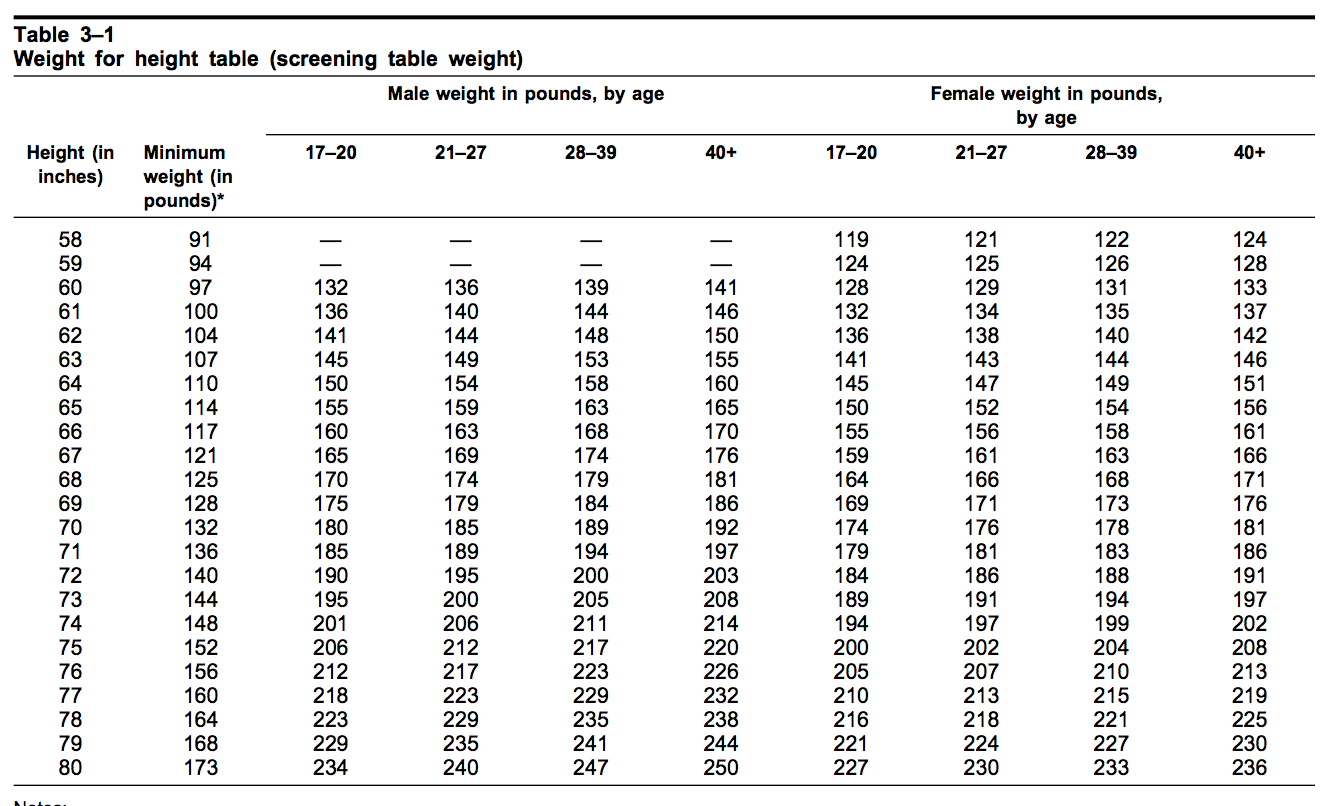Understanding Army Height And Weight Standards: A Comprehensive Guide
Army height and weight standards play a crucial role in maintaining the physical readiness of soldiers. These standards ensure that all service members meet the necessary requirements to perform their duties effectively. In this article, we will delve deep into the various aspects of these standards, including their significance, specific requirements for different branches, and how they are enforced.
From the importance of physical fitness to the implications of not meeting these standards, we will cover a wide range of topics. By the end of this article, you will have a comprehensive understanding of army height and weight standards and how they apply to service members. Let’s get started!
Table of Contents
- Importance of Army Height and Weight Standards
- Detailed Requirements by Branch
- Enforcement of Height and Weight Standards
- Consequences of Failing to Meet Standards
- Body Fat Percentage Standards
- Preparing for Height and Weight Measurements
- Resources for Soldiers and Recruits
- Conclusion
Importance of Army Height and Weight Standards
The army height and weight standards are vital for several reasons:
- Physical Readiness: Soldiers must be physically fit to perform their duties effectively.
- Operational Efficiency: Maintaining a specific weight ensures that soldiers can carry necessary equipment and perform tasks without undue strain.
- Health and Safety: Ensuring soldiers meet physical standards helps reduce the risk of injuries and health issues.
- Discipline: Adhering to weight standards instills discipline and responsibility within the ranks.
Detailed Requirements by Branch
Each branch of the military has specific height and weight requirements. Below, we will explore these standards in detail.
Army Standards
The U.S. Army has set clear height and weight standards based on age and gender. The following table outlines the height and weight requirements for male and female soldiers:
| Height (inches) | Weight (lbs) Male | Weight (lbs) Female |
|---|---|---|
| 60 | 140 | 110 |
| 64 | 150 | 120 |
| 68 | 180 | 145 |
| 72 | 200 | 170 |
| 76 | 220 | 195 |
Navy Standards
The U.S. Navy also has established height and weight standards, which can be found in their official guidelines. Similar to the Army, the Navy uses a table to specify weight limits based on height:
| Height (inches) | Weight (lbs) Male | Weight (lbs) Female |
|---|---|---|
| 60 | 140 | 110 |
| 64 | 150 | 120 |
| 68 | 185 | 145 |
| 72 | 205 | 175 |
| 76 | 225 | 205 |
Air Force Standards
The U.S. Air Force also maintains its own height and weight standards, which are essential for ensuring that personnel are fit for service. The following table summarizes their requirements:
| Height (inches) | Weight (lbs) Male | Weight (lbs) Female |
|---|---|---|
| 60 | 140 | 110 |
| 64 | 150 | 120 |
| 68 | 180 | 145 |
| 72 | 205 | 175 |
| 76 | 225 | 205 |
Marine Corps Standards
The U.S. Marine Corps emphasizes physical fitness and has its own set of height and weight standards. Below is a summary of their requirements:
| Height (inches) | Weight (lbs) Male | Weight (lbs) Female |
|---|---|---|
| 60 | 140 | 110 |
| 64 | 150 | 120 |
| 68 | 180 | 145 |
| 72 | 205 | 175 |
| 76 | 225 | 205 |
Enforcement of Height and Weight Standards
Each branch of the military has procedures in place to enforce height and weight standards. Soldiers must regularly undergo weigh-ins, and their height is measured as part of the assessment. If a service member exceeds the weight limit for their height, they may be required to enter a weight management program.
Consequences of Failing to Meet Standards
Not adhering to army height and weight standards can lead to several consequences:
- Administrative Actions: Soldiers may face reprimands or be required to participate in weight management programs.
- Disqualification from Promotions: Falling out of standards can hinder career advancement opportunities.
- Deployment Issues: Soldiers not meeting the standards may be deemed unfit for deployment.
Body Fat Percentage Standards
In addition to height and weight, the military also considers body fat percentage as a crucial factor. Each branch has specific body fat percentage standards that must be adhered to, ensuring soldiers maintain an appropriate level of fitness. The body fat percentage is calculated using measurements taken from various parts of the body.
Preparing for Height and Weight Measurements
For soldiers and recruits, preparation for height and weight measurements is essential. Here are some tips:
- Maintain a Balanced Diet: Focus on nutrition and maintain a healthy diet to meet weight standards.
- <
Spencer Paysinger: The Inspiring Journey Of A Professional Football Player
Athina Onassis: The Legacy Of A Modern Heiress
Luv Flow Drops Side Effects: What You Need To Know

ARCHIEzzle's True POV What To Expect in the ARMY ARMY HEIGHT & WEIGHT 
My Base Guide Do You Meet the Army Height and Weight Standards? Find 
My Base Guide Do You Meet the Army Height and Weight Standards? Find


